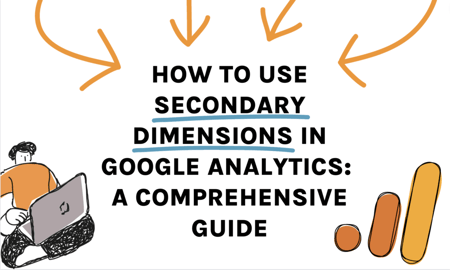Mastering Search Engine Optimization: Using Secondary Dimensions for Improved Analytics
Mastering Search Engine Optimization: Using Secondary Dimensions for Improved Analytics
Blog Article
Enhance Your Information Analysis Making Use Of Additional Measurements
The real depth of understandings exists in the integration of secondary dimensions. The critical usage of secondary dimensions boosts analysis past the surface area degree, promising a riches of untapped possible waiting to be uncovered.
Understanding Secondary Dimensions
Additional measurements in information analysis refer to extra attributes or metrics that offer deeper insights when integrated with main information measurements, boosting the total understanding of the dataset. These extra measurements supply an even more comprehensive view of the data, allowing experts to reveal hidden patterns, relationships, and trends that might not appear when only thinking about primary dimensions.
By integrating second measurements right into data analysis, analysts can gain an extra nuanced understanding of the variables affecting the main metrics. As an example, in advertising analysis, primary dimensions can consist of fundamental customer demographics like age and gender, while second measurements might include variables such as buying behavior, choices, or geographical place. By incorporating these key and additional dimensions, experts can produce a lot more comprehensive consumer profiles, enabling even more targeted and effective advertising and marketing approaches.
In addition, additional measurements can assist in determining relationships between different variables, bring about more accurate anticipating modeling and decision-making. They make it possible for analysts to explore information from multiple viewpoints, improving the understandings drawn from the dataset and eventually improving the quality of evaluation and calculated recommendations.
Advantages of Additional Dimensions
When considering information evaluation, integrating second measurements provides a multitude of advantages that considerably enhance the depth and breadth of understandings originated from main information measurements. One of the crucial advantages of second dimensions is the capability to give context to primary information. By including second dimensions such as time, place, or market details to the evaluation, researchers can acquire an extra extensive understanding of the main information factors - secondary dimensions. This contextual details can help identify patterns, patterns, and connections that might have or else gone undetected.
Furthermore, secondary measurements can likewise help in segmenting data, allowing for an extra detailed analysis of specific parts within the key information. This segmentation can result in more targeted strategies and actions based upon the one-of-a-kind features of each section. Furthermore, secondary dimensions can assist in confirming findings from primary data measurements, supplying a much more reputable and robust basis for decision-making.
Fundamentally, the advantages of integrating secondary measurements right into data evaluation are vital, offering richer understandings and allowing more enlightened decision-making procedures.
Executing Second Measurements Efficiently
When incorporating additional measurements, it is important to straighten them with the primary dimensions to obtain deeper insights right into the information. It is important to choose second dimensions that match the main information without causing sound or complication in the analysis.
Additionally, think about the scalability of the secondary measurements throughout various datasets or analyses. Guarantee that the selected second measurements can be consistently applied and analyzed across numerous situations to preserve the honesty and uniformity of the analysis. Establish a methodical process for integrating secondary dimensions into the analysis workflow to streamline the interpretation of outcomes. By implementing secondary measurements successfully, analysts can boost the depth and precision of their information analysis, leading to even more educated decision-making and workable insights.
Advanced Techniques With Additional Dimensions
For a check here more advanced approach to information evaluation, integrating second dimensions can dramatically raise the deepness of insights acquired. Advanced strategies with secondary measurements entail more complex methods to draw out valuable info from recommended you read information collections.
Another sophisticated strategy is regression analysis, which assists recognize relationships between variables and just how they impact each other. By including second dimensions, such as market info or customer behavior, to regression models, you can discover extra nuanced insights and make more precise forecasts.

Study: Second Dimensions at work

In one more scenario, a healthcare company leveraged secondary measurements to enhance resource appropriation. By examining client outcomes in relationship to geographical area, the company recognized areas with high readmission rates. This caused the application of targeted treatment programs in those regions, ultimately boosting client treatment and decreasing healthcare expenses.
These case researches highlight the power of additional measurements in discovering valuable insights that drive strategic decision-making. By delving deeper right into data evaluation beyond main metrics, companies can acquire an extra extensive understanding of their procedures and customers, bring about more efficient and enlightened business methods.
Conclusion
To conclude, the unification of secondary measurements in information analysis is necessary for obtaining an extensive understanding of underlying variables and trends. By utilizing techniques such as friend evaluation and regression evaluation, organizations can discover surprise understandings and make more informed decisions. Additional measurements add depth and breadth to data evaluation, permitting businesses to explore data from several point of views and drive extra effective outcomes.
In advertising analysis, key measurements might include basic consumer demographics like age and gender, while secondary measurements might encompass variables such as acquiring habits, preferences, or geographical place.When considering information analysis, incorporating second dimensions uses a multitude of advantages click to read more that significantly boost the depth and breadth of understandings obtained from primary information dimensions.Moreover, secondary measurements can also aid in segmenting data, permitting for a more thorough evaluation of particular parts within the key information. Additionally, second dimensions can help in confirming findings from key data dimensions, giving a much more durable and reputable basis for decision-making.
When including secondary measurements, it is crucial to align them with the key measurements to acquire much deeper understandings into the data.
Report this page